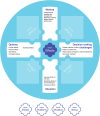The role of the purposeful shared decision making model in vascularized composite allotransplantation
- PMID: 38993756
- PMCID: PMC11235292
- DOI: 10.3389/frtra.2024.1421154
The role of the purposeful shared decision making model in vascularized composite allotransplantation
Abstract
For some patients who have lost the lower part of an arm, hand transplant offers the possibility of receiving a new limb with varying degrees of sensation and function. This procedure, Vascularized Composite Allotransplantation (VCA), is demanding for patients and their care community and comes with significant risks. As a high-stakes decision, patients interested in VCA are subject to extensive clinical evaluation and eligibility decision making. Patients and their care community must also decide if hand transplant (versus other approaches including rehabilitative therapies with or without prosthesis) is right for them. This decision making is often confusing and practically and emotionally fraught. It is complicated in four ways: by the numerous beneficial and harmful potential effects of hand transplant or other options, the number of people affected by VCA and the diverse or conflicting positions that they may hold, the practical demands and limitations of the patient's life situation, and the existential significance of limb loss and transplant for the patient's being. Patients need support in working through these treatment determining issues. Evaluation does not provide this support. Shared decision making (SDM) is a method of care that helps patients think, talk, and feel their way through to the right course of action for them. However, traditional models of SDM that focus on weighing possible beneficial and harmful effects of treatments are ill-equipped to tackle the heterogeneous issues of VCA. A recent model, Purposeful SDM extends the range of troubling issues that SDM can help support beyond opposing effects, to include conflicting positions, life situations, and existential being. In this paper we explore the pertinence of these issues in VCA, methods of SDM that each require of clinicians, the benefits of supporting patients with the breadth of issues in their unique problematic situations, implications for outcomes and practice, and extend the theory of the Purposeful SDM model itself based on the issues present in hand transplant decision making.
Keywords: Purposeful SDM; VCA; model; patient centered care; patient clinician communication; shared decision making (SDM); vascularized composite allotransplantation.
© 2024 Hargraves, Boehmer, Amer, Kennedy, Griffin, Finnie, Montori, Smither, Mardini, Moran and Jowsey-Gregoire.
Conflict of interest statement
The authors declare that the research was conducted in the absence of any commercial or financial relationships that could be construed as a potential conflict of interest. The author(s) declared that they were an editorial board member of Frontiers, at the time of submission. This had no impact on the peer review process and the final decision.
Figures



Similar articles
-
Purposeful Shared Decision-Making in Caring for and with Patients with Chronic Pain Receiving Opioid Therapy.J Gen Intern Med. 2025 May 8. doi: 10.1007/s11606-025-09535-1. Online ahead of print. J Gen Intern Med. 2025. PMID: 40341477
-
A Patient-Centered Website (Within Reach) to Foster Informed Decision-making About Upper Extremity Vascularized Composite Allotransplantation: Development and Usability Study.JMIR Form Res. 2023 Feb 7;7:e44144. doi: 10.2196/44144. JMIR Form Res. 2023. PMID: 36749618 Free PMC article.
-
Education for patients with limb loss or absence: Aging, overuse concerns, and patient treatment knowledge gaps.Front Psychol. 2022 Sep 27;13:953113. doi: 10.3389/fpsyg.2022.953113. eCollection 2022. Front Psychol. 2022. PMID: 36237690 Free PMC article.
-
Shared Decision-Making in Diabetes Care.Curr Diab Rep. 2015 Dec;15(12):112. doi: 10.1007/s11892-015-0688-0. Curr Diab Rep. 2015. PMID: 26458383 Review.
-
Shared decision making in oncology practice: what do oncologists need to know?Oncologist. 2012;17(1):91-100. doi: 10.1634/theoncologist.2011-0261. Epub 2012 Jan 10. Oncologist. 2012. PMID: 22234632 Free PMC article. Review.
Cited by
-
Purposeful Shared Decision-Making in Caring for and with Patients with Chronic Pain Receiving Opioid Therapy.J Gen Intern Med. 2025 May 8. doi: 10.1007/s11606-025-09535-1. Online ahead of print. J Gen Intern Med. 2025. PMID: 40341477
References
Grants and funding
LinkOut - more resources
Full Text Sources
Research Materials

